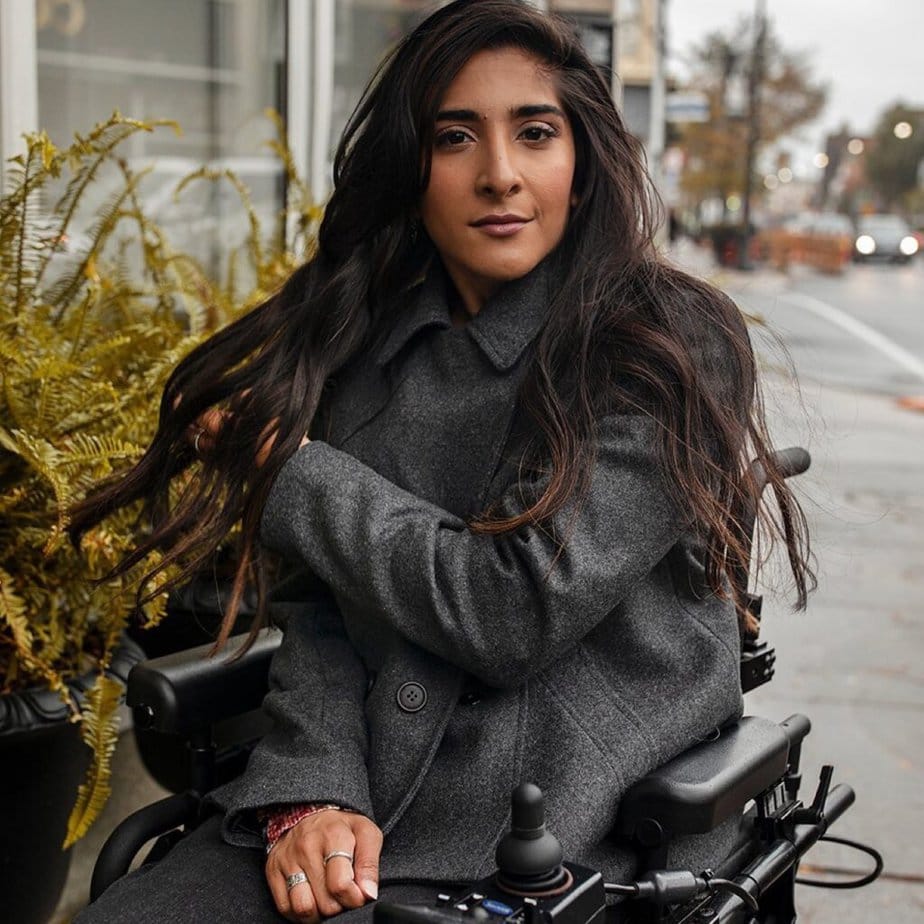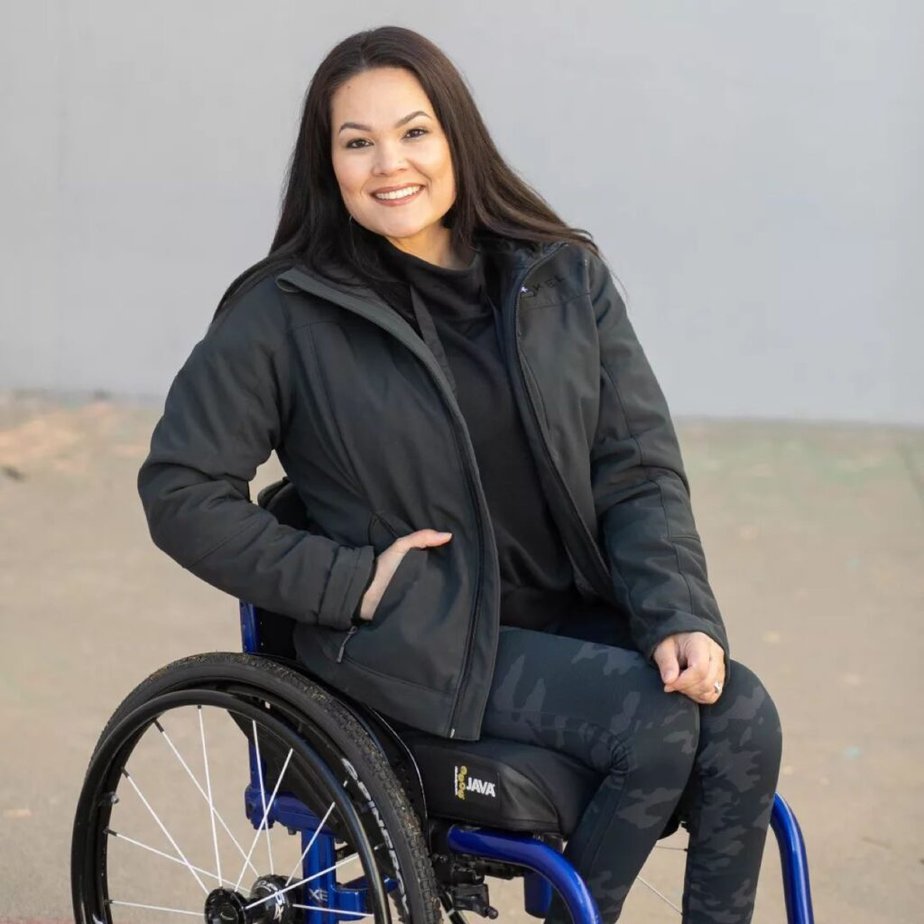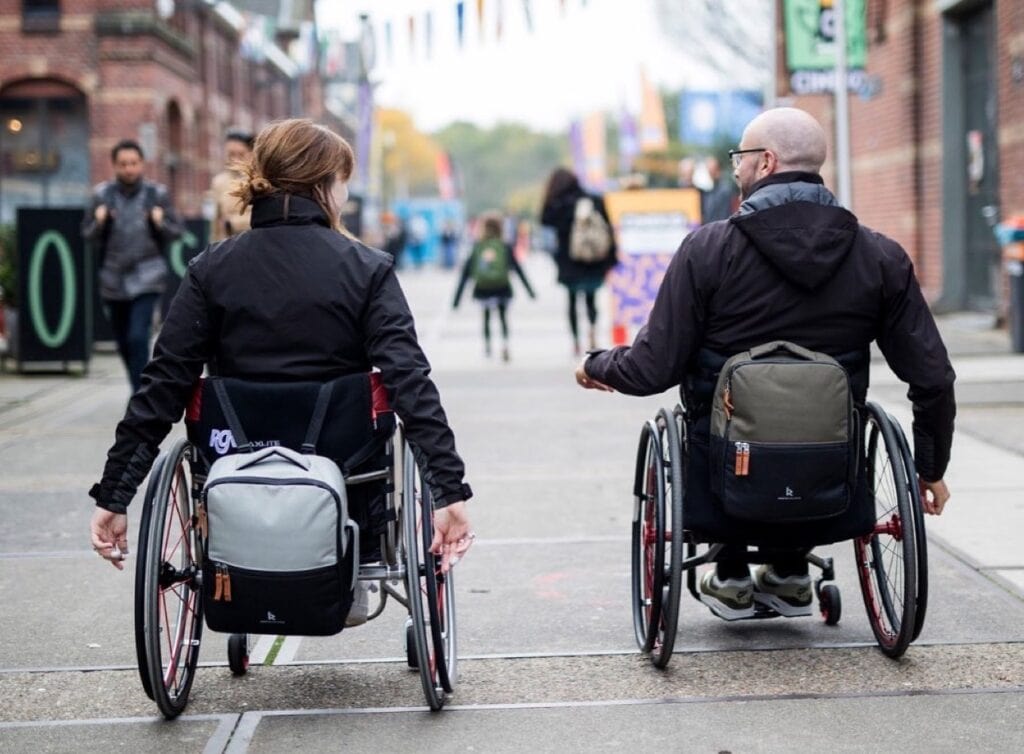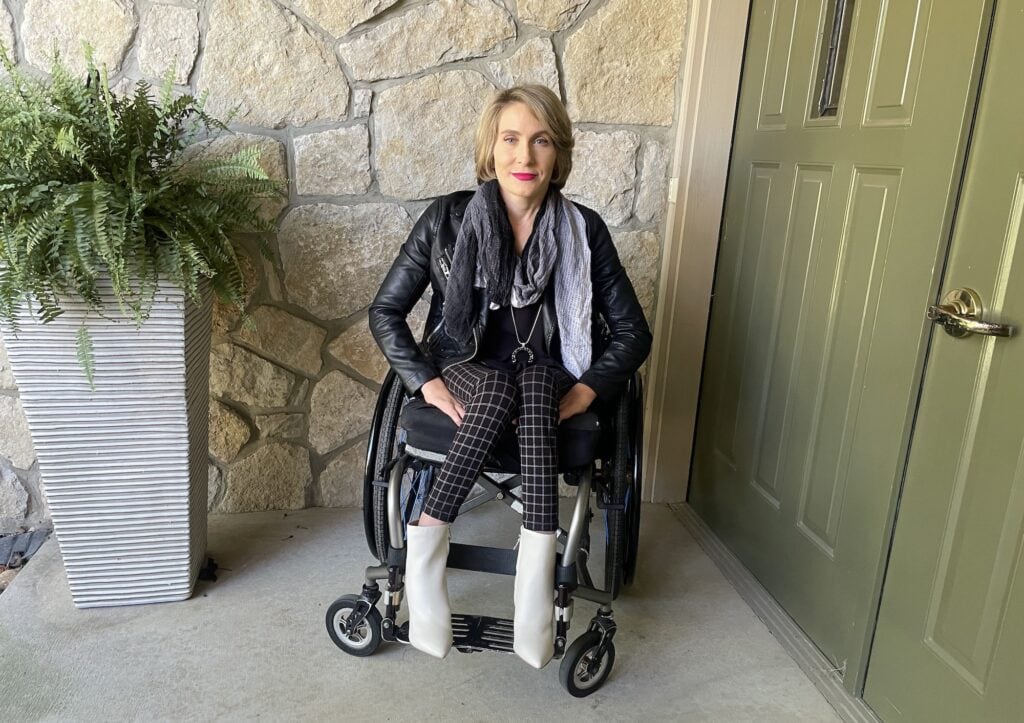Wheelchair Users’ Guide to Fall and Winter Clothing and Accessories
October 3, 2023
Kate Matelan
From down-feather coats and heavier seasonal wear to layers and accessories, this is your cool-weather guide to reshaping “What can I wear?” into “What do I want to wear?”
Whether your fall and winter are harsh, or just kind of cool, dressing as a wheelchair user means new layers, lengths and, quite frankly, more time. Reclaim extra dressing time by building your fall and winter wardrobe with adaptive wear, self-modified gear and carefully selected mainstream garb. It can be done!
This breakdown of styles, fits and fabrics will take some of the work out of searching for functional fall and winter fashions, and includes my personal tips from 20-plus years of dressing as a wheelchair user. My No. 1 recommendation: Pick cozy gear this time of year, but always check that it allows for movement. Bend, push and move your upper body — whatever you can do to make sure the clothing won’t hold you back.
You can jump directly to a section by clicking one of the links below. And be sure to check out our Wheelchair Users’ Guide to Dressing Well, which details jeans, skirts and shorts, swimwear and formal wear.
Fall and Winter Coats

With summer in the past, it’s time to get ready for the long haul of fall and winter. First step: Breaking out the fall or winter coat for the frigid, blustery season. But let me guess — you haven’t been able to find a coat that’s the right length or has the most accessible closures, right?
I know the drill. But thanks to my manual wheelchair thrashing many a coat, I’ve racked up plenty of shopping practice over the years. Through trial and a whole lot of error, I’ve found the hits and misses when giving a new jacket a test run.
Style
You want to look stellar while still wearing a coat style that’s functional. If the coat is supposed to extend well past your knees, then don’t even consider it. The excess fabric from these styles has nowhere to go when you’re sitting, and gets in the way of moving comfortably.
The solution? Opt for styles that are cut shorter or fan out easily at the hips without too much fabric. Bomber and motorcycle jackets are usually shorter styles. Look at peacoats as well, although you’ll find some manufacturers make them too long or too rigid. Ski jackets are a long shot but can work, especially adapted varieties. I find down-feather puffer jackets to be an excellent style, but they don’t always dress up a nice outfit. Take a look at slim-line puffer jackets found at almost any department or outerwear store — they rank high in my jacket choice for warmth, style and all of the reasons below.
Depending on your hand function, closures can be a deal-breaker. As a low-level quad, buttons and zippers can be difficult, but give me snaps or a belt that ties and I’m golden. Some coat styles have several types of closures in one — maybe toggle loops and snaps — so always investigate before you put the jacket in the “no” pile.
If all else fails, I have three go-to options for making the coat work. If you can’t find a closure that fits your function, make sure you invest in a very warm coat and a thick, cozy scarf to fill in the unclosed jacket. Another option is a pullover jacket that eliminates the closure problem altogether. Or if you’re the creative type and your jacket style permits, have the skilled hands of a seamstress sew in Velcro closures.
Length
Short- to midlength jackets are the sweet spot, but there is an exception: adaptive coats.
I stand by my Adaptations By Adrian rain cape for wet days in fall and spring, and rotate in the fleece-lined winter cape for colder, snowy and sleety days. These longer adaptive coats cover arms, legs, and chair parts, and keep you dry. Honestly, the cape is a bit more functional than fashionable, but it is a game-changer. I layer the cape over my winter coat for full body- and chair-coverage.
Other adaptive coat styles also offer added length and take into consideration the seated frame. Check out Tommy Hilfiger Adaptive, IZ Adaptive and online at Target or Kohl’s for other lengths and styles made especially for us.
Fabric and Color

Choosing fabric this time of year is key. Mix delicate fabrics with slush, mud, snow, sleet and ice-melt, and you’ve got a big problem. Throw in a chair or other mobility equipment, and you’re lugging around a lot of that fall and winter mess.
When you’re hunting for the new coat, think about the effects of the elements — most likely the cuffs and bottom of the jacket will be seeing the worst of it. You want a fabric that will wick away the water and/or dry quickly. That’s another reason I love the quilted puffer jacket. Wool coats are great for warmth and provide a decent coat life, but they can absorb a bit of slush on the ends of the sleeves. If leather’s your choice, always make sure it’s treated, or vegan, and beware of it getting eaten up when moving at high speed.
The cleaning tag really gets me: It’s that moment of panic when I decide if I can bring home another “dry-clean only” item. Sometimes you can get away with dry cleaning a jacket twice in fall and winter, but it depends on how hard you wear your clothing and how brutal the elements are that season. Just remember: When your coat is at the cleaners, you need to have a backup. I try to save last year’s coat for those dire moments.
If you get that pesky pilling on your jacket from it rubbing on your chair, buy a garment groomer at the local drugstore. Some of these tools look like plastic combs while others resemble a scratchy Styrofoam square.
As for color, bright colors rock, but they often show all the dirt and wear on a coat. Although you may find it blah, a black, brown or gray jacket is probably your best bet for giving the appearance of being clean and well-maintained. Plus, dark winter coats are much more versatile with your outfits.
Kate’s Top Five Coat Tips:
- Try on the coat with your heaviest clothing. The jacket needs to fit comfortably with the max amount of clothing. Move around and you’ll know right away if it’s the one.
- You get what you pay for. Choosing a coat that’s well made and from a trusted brand is worth the investment when it comes to style and durability.
- Reclaim your old jacket. If the outside of a well-loved coat is still in decent shape but the inside isn’t, simply replace the lining.
- Protect clothing under your coat … at all costs. Keep slush far away from your clothes by pushing up your sleeves underneath the jacket.
- Solid colors aren’t boring. Add a bold pop of color with a scarf or gloves, and you’ve upgraded your solid jacket in an instant.
Fall and Winter Bags

Changing weather conditions are typical this time of year. And so is lugging around more personal and medical items in our bags. Between rubbing against dirty wheels and chair frames and getting caught on every other wheelchair part imaginable, our carryalls endure a lot of wear and tear. Finding one that also fits on your chair without falling off, and opens and closes appropriately, means filling a long list of demands.
Those “wheelchair bags” from chair manufacturers might be designed to fit over the back of your chair, but they often aren’t winning any style points in my book. Believe me, other options do exist. What you ought to have is a swanky, sporty or funky bag that’ll make a statement yet still be functional.
Style
You’ve got a lot of options: backpack, satchel, drawstring, messenger, tote, etc. They all have their pros and cons, but none stick out as an absolute miss. You do, however, need to see how they fit on your chair, and figure out what’s the easiest to get on and off throughout the day.
A major style decider is how each opens and allows you to access the interior of the bag. For example, backpacks unzip completely, letting you reach in at any angle, while a messenger only allows access from the top. You’ll want a style that matches how you or a companion can best get to whatever is inside. Plus, the type of bag needs to fit your style — it’s more than a bag, it’s something that screams, “This is all me!”
Zippers, snaps and Velcro are all typical bag closures. You can always play around with keychains and other key rings to make zippers more convenient. Be sure that the closure style actually shuts your bag and protects all valuables. Since it’ll be hanging on the back of your chair, you want to make sure someone can’t rummage into your bag or that something can’t tumble out.
Keep your eye out for an easy-to-access side or outside pocket too. Fall and winter weather can get grimy, making it crucial to have quick access to wipes, winter gloves and a junk towel to wipe down wheels.
Size
Your choice of bag size is dependent upon what you intend to pack and the style of your chair. It also depends on what weather conditions you might encounter through the day. Leave room for bulkier items and extra accessories. You want enough room to get your goods in and out, but not so much that it creates a black hole for your meds or car keys.
The biggest factor is the configuration of your chair — be sure the size of the bag fits on your ride snugly without inhibiting any wheeling or getting prodded by wheelchair parts. You want it to be secure so you don’t innocently lose your belongings and someone can’t snatch it off the back of your chair. Move around with the bag to see if it drags on the ground or gets twisted when you push or pop a wheelie.
Fabric and Color
Durability and washability are the top two musts for any bag fabric. I use my bags to carry around my personal life and my cath life, so there are a lot of fluids involved. If my lubricant explodes, I don’t want to have to dry-clean my bag and wonder if that spot might be there long-term.
Fall and winter weather can get grimy, making it crucial to have quick access to wipes, winter gloves and a junk towel to wipe down wheels.
Avoid leather and suede since those textiles probably won’t handle a lot of chair rubbing, spills or seasonal weather elements as well as other fabrics. A nylon backpack works best. It’s durable and washable, so you can count on it to maintain its strength and be cleaned in a flash. If you’re caught in wet weather, a nylon bag can dry off quickly. Another option is a clothlike tote for dependability, but be cautious of a soaking precipitation, since moisture may linger. No matter the fabric, make sure the straps on your bag are sturdy and sewn in well; they’ll take a lot of stress hanging on your chair.
Darker colors rule when it comes to masking the wear and tear your bag will endure from fall and winter wheeling and being dropped or dragged on all kinds of surfaces. However, solids are a bit of a bland option. To upgrade something plain, add buttons, screen printing, customization, etc., for personal flair, but don’t go overboard or start bedazzling your bag to no end. Too many extras can tangle up in your chair.
If you want to ditch the solids, try a printed bag that incorporates bold colors with a darker undertone — for example, a pattern of orange, green and tan with a brown undertone. The brown will keep your backpack from looking too dirty or scuffed while still maintaining that pop of color. You may be toting your bag to an important meeting or get-together — keep that in mind when picking a print.
Kate’s Top Five Bag Tips:
- Consider the weight. A full bag might throw off the balance of your chair or add excessive weight to your wheeling.
- Add some security. If you’re rocking handlebars, buy some rubber chair-leg protectors and squeeze them on the end of your bars to keep your bag in place.
- Cross the straps. Try crisscrossing the straps to make a tote fit on the back of your chair without too much bulge.
- Leave your name and number. Keep a business card or note in your bag in case you accidentally lose it. Some items in our bags are mission-critical.
- Go for storage spots. Pockets on the inside and out are great for cellphones and other items that you need readily accessible.
Fall and Winter Layers

Love it or hate it, fall and winter are all about layers. Multiple shirts, sweaters, jackets, fashion scarves, socks, leggings and pants are part of the wardrobe. As a wheelchair user, that equates to longer dressing minutes, pressure sore considerations, movement conundrums and, honestly, grumpiness — for me at least. I’m all about the quicker and easier dressing during the warm weather.
But it doesn’t have to be doom and gloom. And there are good reasons for layering up when it’s cold outside. Keeping your body warm, especially where you can’t feel and circulation might not be tiptop, is important. Protecting yourself when going out to dinner or a holiday party is smart, but it doesn’t mean you have to let go of fashion for function.
Style
Layers are ideal for warmth but can also be a real pain in the ass when it comes to care or body-temp fluctuations. Look for fits that aren’t an absolute struggle to get on or off, solo or not. Or, plan your layered look by what type of care you may need that day or who will be with you.
Before adding a new layered piece to your wardrobe, ask yourself, “Will this be an absolute pain to wear? Can it fit under or over another item? Will it work under my coat?” It seems simple, but being realistic is super-important. You want ease and versatility in your fashion.
Length and Size
Go long. Cover your arms and legs. Ankles too. Exposure to fall and winter temps has other consequences, plus so many of us can’t control our temps anyways.
With atrophied bodies comes a range of leg- and arm-sizes. As a petite female with atrophied legs and muscular arms, I oftentimes buy kids regular-size bottom layers and adult petite-size top layers. If I’m wearing two pairs of pants, my base layer may be a kids size and the second layer an adult size.
Mix and match lengths and sizes to get the coverage, fit and layering ability that makes sense for you. I build out my top layers from least coverage to most coverage, aka cami, T-shirt, cozy sweater, chunky cable scarf. For my bottom layers, I go opposite, keeping most coverage from hip to ankle as my first layer and then adding socks and boots over top. I lock in the warmth at my legs, the coldest part of me, and give myself the ability to disrobe my top if I get hot.
Fabric and Color
Thin, warm fabrics are a wheelchair user’s best friend: less bunching and more cozy. Combining these fabrics together, and in the right order, makes or breaks the day. Start with thinner fabrics close to your skin and build out from there. Reminder: Bulky doesn’t necessarily equal warm. Nor does it always lend itself to flexibility.
As a petite female with atrophied legs and muscular arms, I oftentimes buy kids regular-size bottom layers and adult petite-size top layers.
Gravitate toward mixed-material shirts, blazers and other clothing. These allow for easy layering and pushing, with a finished look in the front and stretchy material on the back.
I recommend Under Armour ColdGear or a similar, technology-focused thin underlayer. Dual-layer fabric with a warm underlayer and wicking components checks all the boxes for skin contact. Put these must-haves under shirts and pants for added warmth, or wear solo around the house. My advice: Start with a tried-and-true black set, then branch out into colors and patterns. Many styles are designed so that they can be your whole outfit too.
Thin, thermal sock fabrics are also crucial. Fit into sneakers, boots and other shoes without stress and strain — that’s where these winter staples save the day. Stock up on solid shades for the utmost versatility, but don’t shy away from bright and colorful or whimsical socks. With exposed socks back in fashion — at least right now — and fall and winter boots covering up most of the fabric, there are no color rules.
Embrace fall colors, wintry shades, and everything in between. Incorporate patterns, prints, sparkles and whatever else feels right. Fall and winter tend to have richer, darker hues which, honestly, help hide dirt and debris.
Fall and Winter Accessories

Gloves, hats, scarves! The trifecta fends off the chill and supplements coat styles and other layers this time of year. They’re my go-to for cold fall mornings and crisp afternoons or the all-day freeze-fest in the middle of winter.
Accessories can help to avoid bulky sweaters or itchy pullovers and more restrictive layers, without sacrificing warmth. Can’t layer too much clothing because of skin issues? Need easier and faster access for care down there? Running out of time before heading out the door? Many accessories solve these dilemmas and more while providing a weather-appropriate outfit with style.
Style
As a manual wheelchair user, fall and winter gloves are the hardest part of my outdoor garb. The need for traction on wet, slippery terrain is key, which lends itself to fingerless gloves –– however, ice-melt and frigid temps don’t mix well with exposed fingers.
Both fingerless or fully covered finger gloves with traction beads on the underside are viable options. The stress test: Try on the gloves and see if they pull between your fingers when maneuvering. If so, it’s a hard “no” on the style. Don’t dismiss adaptive ski-glove styles with side zippers and other easy in/out or on/off features.
Hats and scarves are an absolute must in fall and winter. Experiment with different styles — think short, long, wraparound, tied or bucket, flapped, beanie or trapper. The biggest style consideration for scarves is how they fit when sitting. Avoid anything that might get tangled in wheels, wheelchair backs, or other layers. And with multiple ways to style or tie scarf-shapes, a long scarf may work perfectly if you cross or wrap it around.
Fabric and Color
Most fashion gloves are cotton- or fleece-based and absorb rain and snow easily, making for soggy hands. Look for water-resistant or quick-dry fabrics, or cover up cotton with your all-weather wheelchair push-gloves. Outerwear companies and outdoor-focused businesses often have fabrics more suited to chair users.
Gravitate toward more neutral glove colors with an emphasis on gray shades for winter use. Gloves may have the most contact with sloppy snow or white ice-melt residue. Darker shades or colors are often the easiest-to-maintain option. But let’s say it: If you like it, buy it. Favorite color is light pink? Do it. Just be ready for extra cleaning or more dirt to show.
Go semiwild with hats and scarves. Basic-colored jackets and neutral gloves don’t provide a lot of pop. Scarves and hats have less contact with your chair, and the fabric and color show off your personality. Ensure the fabrics don’t irritate your skin, give you brush burn when moving, or absorb too much moisture if wearing outdoors.
Kate’s Top Five Accessory Tips:
- Invest in a water-resistant hat with ear flaps. Stay warm and dry without your hat flying off. Plus, head and ear coverage is key to maintaining body temp.
- Buy a short, thick infinity scarf. This style covers your exposed neck when your coat is fully or almost fully closed.
- Have multiple types of gloves on hand. Pun intended. Your below-zero glove choice might be different than your apple-picking day glove. Be ready for anything.
- Beware of open-weave scarves. Zippers, earrings and other jewelry tangle up in these oh-so-cute options. When you’re speeding around in the cold, you don’t want to stop in the snow for this snafu.
- Organize your accessories. Scarf hangers and holders, and baskets or boxes, hold accessories for easy grab-on-the-go.
Support New MobilityWait! Before you wander off to other parts of the internet, please consider supporting New Mobility. For more than three decades, New Mobility has published groundbreaking content for active wheelchair users. We share practical advice from wheelchair users across the country, review life-changing technology and demand equity in healthcare, travel and all facets of life. But none of this is cheap, easy or profitable. Your support helps us give wheelchair users the resources to build a fulfilling life. |


Love it! Keep the fashion coming!
TOTALLY disagree on real Leather. It is a fantastic, durable, and great wearing material, that looks great, lasts a LONG time, is conformable to each person’s body, is compostable and doesn’t pollute the environment like synthetics do, and is incredibly warm especially if the sheepskin (if sheep leather) is on the inside.
I understand if the writer and others are vegan, everyone is free to choose.
For those of us who are omnivores, this is also the way to use all the amazing gifts this animal has given us, head to toe.
Animals if raised regeneratively, are a net negative on CO2 and methane emissions, so that is the way to ethically wear leather.
Re backpacks, I couldn’t disagree more. Synthetic fabrics are awful. They feel awful, weaar awful, and break down quickly, necessitating throwing it away, which ends up as pollution. Natural fabrics and especially Leather is 100% the way to go, in my experience. It looks amazing, feels wonderful, and wears INCREDIBLY well, *forever*. I am incredibly hard on my clothes, being a veterinarian and working on my farm, and leather just works. Natural fabrics work, period.
Wool, also, like that lovely grey wool peacoat on the lovely model, is a fantastic material, that breathes, keeps us warm in the winter, *even when wet*, and cool in the summer. It is truly a beautiful ”ninja” fabric that is also looks great and feels great. From woven fabrics like that pictured grey coat, to knitted wool sweaters, wool is truly amazing. And importantly, wool will not clog our waterways and soil and air with plastic microfabric particle pollution, that is poisoning all living things.
Natural fabrics are totally the way to go, in my experience, leather included.
I agree. My leather bags and boots last for years. I pair a cotton t-shirt with wool sweater and scarfs. Always works. I live in Minnesota it gets COLD here. I have proper snow boots that have lasted for years. Totally worth the money. I lost my leather insulated gloves. So a new pair is needed.
100%
I lost my insulated leather mittens last year too, Big loss for me because they gripped so well on my rims and they were REALLY warm. lnsulated thicker leather gloves or mittens are hard to find nowadays 😔